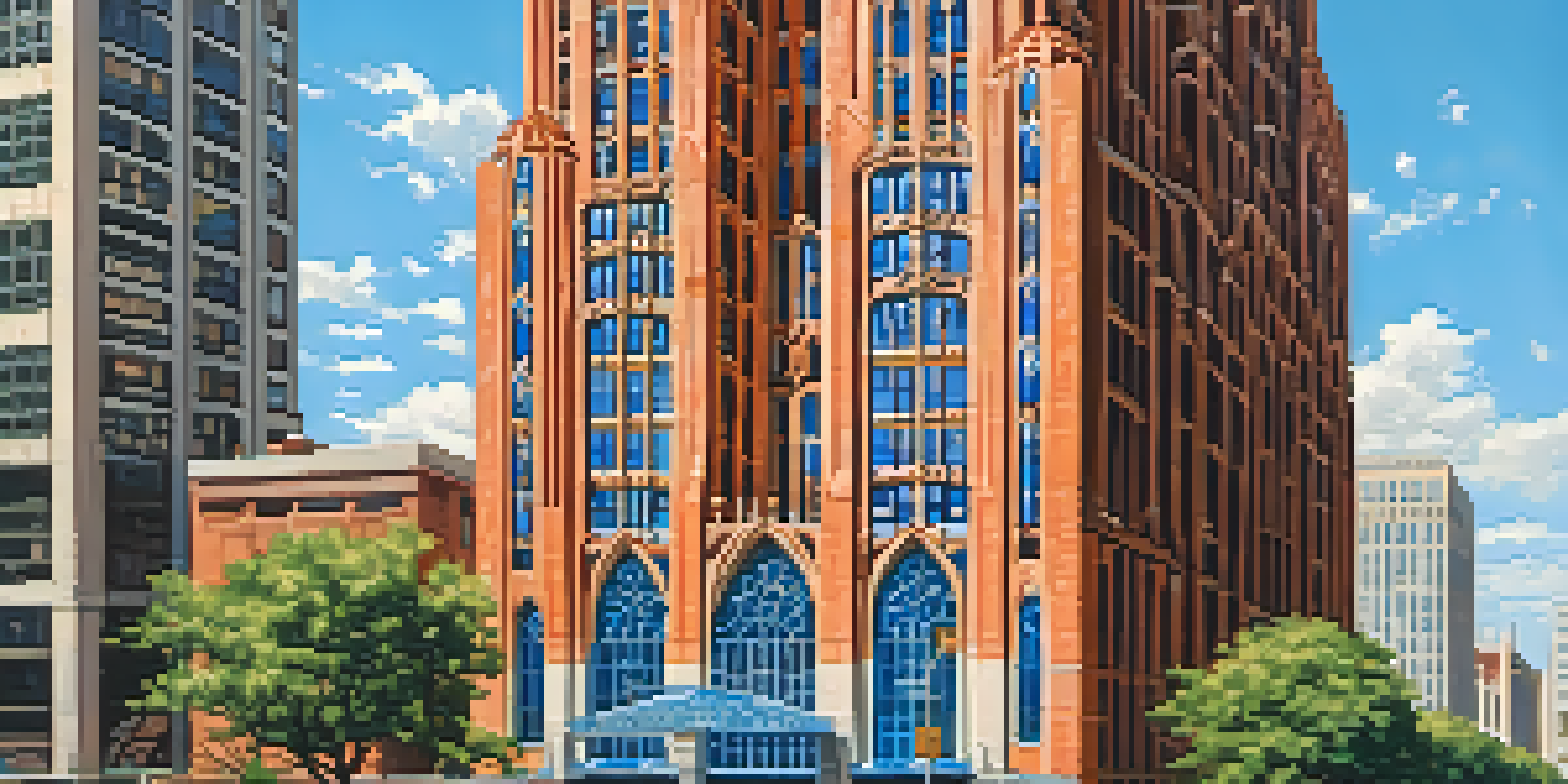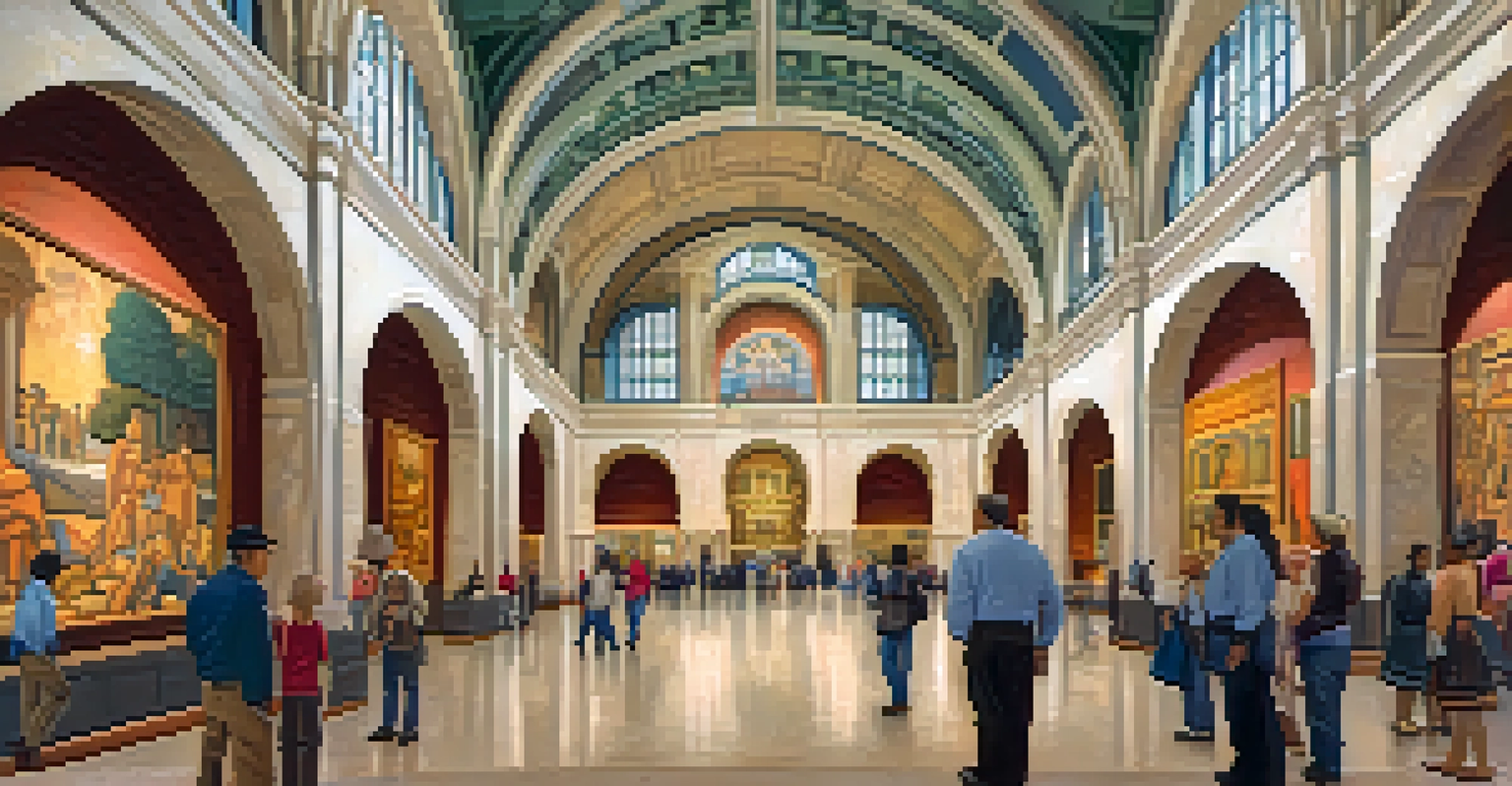Historic Landmarks of Detroit: Preserving the Past

The Guardian Building: A Gem of Art Deco Architecture
The Guardian Building, often referred to as Detroit's 'cathedral of finance,' showcases stunning Art Deco design that reflects the city's rich history. Completed in 1929, its vibrant blue and orange tiles are a sight to behold, drawing visitors from around the globe. This landmark is not just a beautiful structure; it's a symbol of Detroit’s resilience and growth during the economic boom of the early 20th century.
Architecture is the learned game, correct and magnificent, of forms assembled in the light.
Inside, the building features intricate murals and stunning craftsmanship that tell the story of Detroit's industrial legacy. Walking through its halls, you can almost feel the energy of the bustling 1920s, making it a perfect example of how architecture can encapsulate a moment in time. The Guardian Building stands as a testament to the city’s dedication to preserving its history through beautiful design.
Today, the Guardian Building is not only an office space but also a popular spot for events and tours, ensuring that its legacy continues to inspire new generations. As we admire its beauty, we are reminded of the importance of preserving such landmarks for future enjoyment and education.
The Detroit Institute of Arts: A Cultural Treasure
The Detroit Institute of Arts (DIA) is more than just an art museum; it's a vibrant cultural hub that showcases the city's artistic spirit. Home to over 65,000 pieces of art, the DIA features everything from ancient artifacts to contemporary masterpieces, attracting art lovers from all walks of life. Its iconic Diego Rivera murals are particularly celebrated, depicting the rich history of the city’s labor force.

Visiting the DIA offers an immersive experience where one can explore diverse cultures and artistic expressions. The museum plays a critical role in community engagement, hosting educational programs that foster appreciation for the arts. This dedication to accessibility ensures that everyone has the opportunity to experience the beauty and significance of art.
Detroit's Architectural Marvels
Landmarks like the Guardian Building and Fox Theatre highlight Detroit's rich architectural heritage and cultural significance.
Moreover, the DIA's efforts to preserve its collection reflect a broader commitment to cultural heritage. By safeguarding these artworks, the museum ensures that future generations can connect with Detroit's past and celebrate its artistic achievements.
The Motown Museum: Celebrating Musical Heritage
The Motown Museum, located in the former home of Motown Records, is a must-visit for music enthusiasts and history buffs alike. This small but mighty museum is where legendary artists like Stevie Wonder and Diana Ross recorded some of their biggest hits. The building serves as a time capsule of the 1960s music revolution that not only shaped Detroit but influenced the world.
Music can change the world because it can change people.
Walking through the museum, visitors are greeted by memorabilia and exhibits that tell the story of Motown’s rise to fame. The iconic 'Hitsville U.S.A.' sign still hangs proudly outside, reminding us of the magic that was created within those walls. Each item in the museum helps to preserve the legacy of a genre that changed the landscape of American music.
The Motown Museum also plays an essential role in educating visitors about the cultural significance of the Motown sound. By highlighting the stories of its artists and producers, the museum preserves a crucial piece of Detroit's identity and inspires future generations of musicians.
The Henry Ford Museum: Innovation and History
The Henry Ford Museum is a treasure trove of American innovation, showcasing the inventions and ideas that have shaped our nation. Located in nearby Dearborn, this museum features an extensive collection of artifacts, from the original Rosa Parks bus to the Ford Model T. Each exhibit offers a glimpse into the past, highlighting how Detroit became a hub of industrial progress.
Through interactive displays, visitors can engage with the history of American manufacturing and transportation. The museum offers a unique opportunity to learn about the people and events that have influenced our modern world. By preserving these artifacts, the Henry Ford Museum ensures that the stories of innovation are not forgotten.
Cultural Institutions Thrive
Museums such as the DIA and the Motown Museum celebrate Detroit's artistic spirit and musical legacy, engaging the community through education.
Additionally, the museum hosts events and educational programs that inspire curiosity and creativity. By connecting visitors with the history of innovation, it fosters a sense of pride in Detroit's contributions to the broader narrative of American history.
The Fox Theatre: A Beacon of Performing Arts
The Fox Theatre is a stunning example of Detroit's rich performing arts scene and architectural grandeur. Opened in 1928, this historic venue features a lavish interior that transports guests to a bygone era. With its ornate decor and majestic atmosphere, the Fox Theatre has hosted countless performances, from Broadway shows to concerts, making it a cultural cornerstone of the city.
The restoration of the Fox Theatre in the early 1980s marked a significant turning point in Detroit's revitalization efforts. By preserving this landmark, the city not only saved a piece of its history but also revitalized the surrounding area, attracting tourism and fostering community pride. Today, it stands as a testament to the importance of preserving cultural landmarks.
As a venue that continues to showcase top-tier performances, the Fox Theatre enriches Detroit's cultural landscape. Each show is a reminder of the city’s vibrant artistic spirit and the importance of nurturing the performing arts for future generations.
The Detroit Historical Museum: A Journey Through Time
The Detroit Historical Museum offers a comprehensive look at the city's evolution, from its founding to the present day. With engaging exhibits and artifacts, the museum tells the story of Detroit's diverse communities and significant events. It serves as a vital resource for understanding the complexities of the city's history, making it a must-visit for anyone interested in learning more about Detroit.
One of the museum's highlights is the 'Detroit 67: Looking Back to Move Forward' exhibit, which examines the pivotal year and its aftermath. By addressing both the challenges and triumphs of the past, the museum encourages reflection and dialogue about Detroit's future. This approach fosters a deeper understanding of the city’s resilience and the ongoing journey toward progress.
Nature and History Unite
Belle Isle Park offers a serene escape while showcasing Detroit's commitment to preserving natural spaces and historical landmarks.
The Detroit Historical Museum also emphasizes the importance of community involvement in preserving local history. Through workshops and events, it invites residents to share their stories, ensuring that the rich tapestry of Detroit's history is celebrated and remembered.
The Belle Isle Park: Nature Meets History
Belle Isle Park is a beautiful oasis in the heart of Detroit, blending natural beauty with historical significance. This island park features stunning landscapes, recreational areas, and several historic structures, including the Belle Isle Aquarium and the Dossin Great Lakes Museum. It serves as a reminder of the city’s commitment to preserving green spaces for its residents and visitors alike.
As a place where locals and tourists can unwind, Belle Isle offers a unique perspective on Detroit’s history and culture. The park's rich history dates back to the late 19th century, when it was transformed into a public park. Today, it stands as a testament to the city’s dedication to maintaining accessible spaces for enjoyment and education.

Belle Isle Park also hosts various events and activities that highlight its historical landmarks and natural beauty. By engaging the community in these experiences, the park fosters a sense of connection to Detroit’s history while promoting environmental stewardship.